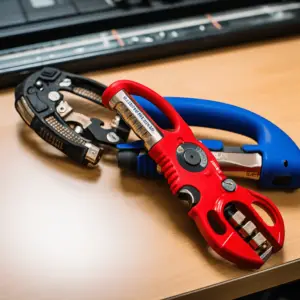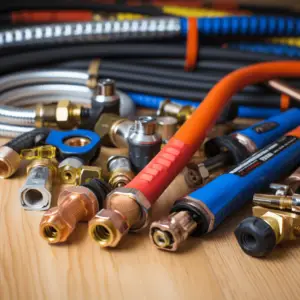Pex Cinch and Crimp, Plumbing tools can frequently be a burden if used incorrectly. On the other hand, the right equipment makes plumbing effective and enjoyable. Pex Crimps and Pex Cinch are major plumbing tools for close combat that are heavily contested.
You need Pex crimps and Pex Crinch to connect a water line; a connection can be completed using either of the two plumbing tools. To make your connection flawless, you should have the right knowledge and precision. In the end, many factors can improve the plumbing, but Pex Cinch wins the prize compared with Pex cramp because of its adaptability.
In addition, there are many other differences between the two, including price variations, processes to fit, materials and purposes. As a result, there are many more differences than just one, as we will discover below. That brings up the most straightforward argument as to which is superior in the battle between Pex Cinch vs. Pex Crimp.
Table of Contents
Pex Cinch Vs. Crimp: Comparison Table

| Pex Cinch | Pex Crimps | |
| It’s the recent and easier method of fixing leakas and geconnections. | It’s a traditional fixing method with reliable accuracy. | |
| Stainless Steel rings included. | Copper crimp rings included. | |
| Onlyone tool is needed to make a connection. | Requires many tools for a perfect connection. | |
| Expensive. | Cheap and faster. | |
| Require experts. | Anyone can pull it off. | |
| Stainless steel rings lower chances of corrosion. | Copper rings are subjected to corrosion. | |
| More durabile. | Corrosion makes it last for some years. | |
Pex Cinch Vs. Crimp: Differences
The primary difference between a pex cinch and a crimp tool is that the crimp slides over the joint and completely squeezes it. While a cinch connection does the same, it may also be used in narrow spaces where a crimp is problematic. However, it becomes challenging to pick a side when the conflict reaches these heights. Each tool has a unique set of benefits and drawbacks. Both tools have the desired durability and flexibility, distinguishing them from one another.
Pex Crimp is the best option if you want to fix it quickly and securely at a low cost. They are ideal for home use since they are affordable. A stainless steel cinch clamp is what you should get if you want something that will last for a long time and is more durable, regardless of price. The Pex cinch clamp is regarded as the best option to be used by businesses since cinch clamps require less maintenance. They are also quick and straightforward to fix. Surprisingly, Pex Cinch is employed in the industrial sector because of its efficiency and flexibility in confined spaces.
-
Pex Cinch Pros
They are made of stainless steel rings, which are less likely to rust. Since pex cinch offers a quick and effective remedy, it’s a more straightforward fixing procedure and more enticing to customers. It works best in either copper or stainless steel rings.
Pex cinch can be used in confined areas. As a result, they work well in building concrete repairs, in addition to strengthening the weaker areas.
You can connect cinch clamps with the Cinch Tool using a variety of pex sizes since it is size-friendly. Another icing on the cake is its recyclable fittings. That undoubtedly makes it a handy item.
-
Pex Cinch Cons
Unfortunately, there may be drawbacks with Pex Cinch Tools as well. They need to be calibrated to get the best possible connection. That also means that a skilled individual must make the connection.
In addition, the cost might vary based on the materials used and the connection method. Its copper ring is slightly narrower than its stainless steel version. Therefore, it may bow under intense pressure, resulting in leakages.
-
Pex Crimp Pros
Pex Crimp is affordable and incredibly accurate. The included “go/no go gauge” guarantees a watertight connection. That will show you whether the connection is tight or loose. Additionally, it can strengthen the entire pipe.
Due to its quicker fixing, it’s the plumbers’ first preference. Anyone, ranging from newbies to experts, may utilize it because of the gauge characteristic and simple-to-apply procedures. They are also available if you’re seeking stainless steel pex crimp rings.
-
Pex Crimp Cons
The Pex crimping technique only comes in a few sizes, so you could need numerous tools, raising the entire cost. Because they are built of copper, they are less adaptable and are more likely to rust.
Furthermore, a weak connection may contract and rupture, producing leakage. Pex Crimp might also be a drawback for some people because it’s challenging to utilize in tiny spaces.
Pex Cinch Vs. Crimp: Which Is Better?
Connecting PEX pipes to fittings and other pipes can be accomplished in different ways. Crimp and cinch connections are frequently preferred to connect PEX-A and PEX-B tubing. These techniques involve using a specialized tool to squeeze a ring over the pipe. Despite having a similar fundamental idea, these approaches are not the same.
The clamp connection is another name for a cinch connector. They are made of a cinch clamp, a unique cinch tool, and the necessary fittings. Because the tool doesn’t wrap around the tube in this approach, it is considerably simpler to use in confined locations. Contrary to the crimp tool, which is designed for a single size, the cinch tool is compatible with various PEX sizes. In addition to being more adaptable, the cinch tool is less expensive than the crimp tool. Cinch rings may cost a little bit more than crimp rings. A tight connection will endure for at least five years and perhaps even ten.
Pex Cinch

A crimp ring, a crimp tool, appropriate fittings, and a go/no-go gauge are the components of a crimp connection. When prepared correctly, this connection is a quick and cost-effective way to connect PEX. Several shops conveniently offer rings and other tools. Using the go/no-go gauge is the only way to determine whether a connection has been made correctly. The link is secure if the gauge doesn’t move over the ring after you place it there. Crimp connections have the disadvantages of being difficult to work within small locations and becoming loose over time, leading to leaks.
Both cinch and crimp connections are reliable in the end. Budget, convenience, and the size of the area being worked on are just a few of the variables that must be considered. It ultimately boils down to personal preference on which one to select. Due to their similar uses, the two tools might be considered friendly competitors. So choosing one over the other is much more difficult. Before selecting one that fits, one should also consider the intention, cost, usage, and other factors.
